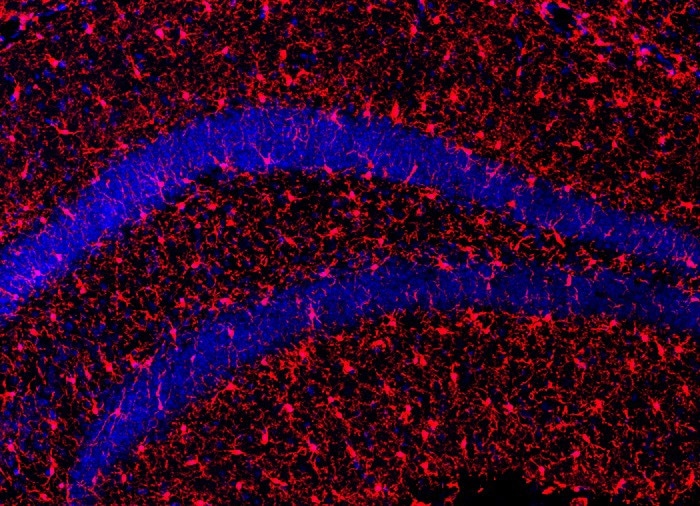Reviewed by Lexie CornerMay 8 2025
An international study led by the Institut de Neurociències at the UAB (INc-UAB) found that increasing levels of the Klotho protein in mice extends lifespan and enhances both physical and cognitive health with age.
 Microscopic image of microglial cells (part of the brain's immune system, in red) from the hippocampus of s-KL-treated mice. The treatment increased the number of cells, improving their phagocytic activity, which is usually impaired during brain ageing. Image Credit: Universitat Autònoma de Barcelona
Microscopic image of microglial cells (part of the brain's immune system, in red) from the hippocampus of s-KL-treated mice. The treatment increased the number of cells, improving their phagocytic activity, which is usually impaired during brain ageing. Image Credit: Universitat Autònoma de Barcelona
It is normal to lose bone and muscle mass with age, which increases the risk of falls and serious injuries, and contributes to overall frailty. In the brain, neurons gradually deteriorate and lose connections, while conditions such as Parkinson’s and Alzheimer’s become more common. Reducing these effects is one of the primary scientific challenges in societies with increasingly aging populations.
An international research team led by Professor Miguel Chillón, an ICREA researcher at the INc-UAB, has demonstrated in a study published in Molecular Therapy that increasing levels of the secreted form of the Klotho protein (s-KL) can slow aging in mice.
The researchers administered gene therapy vectors to young animals, boosting the secretion of s-KL by their cells. At 24 months of age - equivalent to approximately 70 human years - the treated mice showed improved muscle strength, bone density, and cognitive function.
We have been working with the Klotho protein for some time, due to its therapeutic potential for treating neurodegenerative diseases. In this study, we wanted to see whether s-KL could also be beneficial for healthy aging by examining a broad range of factors.
Miguel Chillón, Professor, Institut de Neurociències, Universitat Autònoma de Barcelona
In addition to having larger muscle fibers, reduced fibrosis, and improved physical performance - all indicators of better muscle health - mice treated with s-KL lived 15–20% longer. Improvements in bone health were also observed, particularly in females, with greater preservation of the internal bone structure (trabeculae), suggesting a possible protective effect against osteoporosis.
Finally, s-KL therapy enhanced immune activity in the hippocampus and promoted the growth of new neurons in the brain, indicating potential cognitive benefits.
The viral vector treatment works by introducing copies of the gene that encodes the desired protein into the body’s cells, enabling them to produce it on their own. These vectors were delivered both intravenously and directly into the mice’s brains to ensure that brain cells produced s-KL.
We now have viral vectors that can reach the brain after being administered intravenously, which would make it easier to safely transfer this therapy to humans. Another option would be to administer the protein directly as a drug instead of using viral vectors, but we still need to find an efficient way to deliver it and ensure it reaches the target organs.
Joan Roig-Soriano, Study First Author and Researcher, Institut de Neurociències, Universitat Autònoma de Barcelona
The research group had previously patented the use of Klotho for treating cognitive deficiencies, and three new patents have been filed as a result of this study. These cover the use of Klotho in treating bone and muscle deficits, as well as its potential role in promoting longevity.
“If we can find a viable delivery method, s-KL could make a significant contribution to improving people’s quality of life and helping to build the healthiest society possible,” the researchers concluded.
Source:
Journal reference:
Roig-Soriano, J., et al. (2025) Long-term effects of s-KL treatment in wild-type mice: enhancing longevity, physical well-being, and neurological resilience. Molecular Therapy. doi.org/10.1016/j.ymthe.2025.02.030.